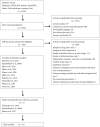The Relationship Between Childhood Physical and Sexual Abuse and Adolescent Cannabis Use: A Systematic Review
- PMID: 34122168
- PMCID: PMC8187570
- DOI: 10.3389/fpsyt.2021.631245
The Relationship Between Childhood Physical and Sexual Abuse and Adolescent Cannabis Use: A Systematic Review
Abstract
Background: Among adolescents, cannabis use is a health concern due to associations with drug addiction and mental health disorders across the life course. It has been shown that childhood maltreatment is associated with drug addiction in adulthood. However, a better understanding of the relationship between maltreatment and drug use may improve targeted prevention and interventions. The aim of this systematic review is to describe the association between exposure to childhood maltreatment, specifically physical and sexual abuse, with adolescent cannabis use. Methods: A systematic search strategy was applied to Embase, PsycINFO, and Ovid MEDLINE(R) databases. Methods followed Preferred Reporting Items for Systematic Reviews and Meta-Analyses (PRISMA) guidelines. Abstract and title screening was performed to identify papers which reported an estimate of the association between childhood physical or sexual abuse and adolescent cannabis use. Full text screening of each paper was performed, and data were extracted and study quality assessed. Weighted means meta-analysis was performed on studies reporting odds ratios as effect estimates. Results: Of 8,780 screened articles, 13 were identified for inclusion. Eight papers received a quality rating score indicating lower risk of bias. Eleven papers reported the relationship between childhood sexual abuse and adolescent cannabis use; effect estimates ranged from AOR 0.53-AOR 2.18 (weighted mean OR 1.29, 95% CI 1.08-1.49). The relationship between childhood physical abuse and adolescent cannabis use was reported in 7 papers; effect estimates ranged from AOR 1.25-AOR 1.87 (weighted mean OR 1.39, 95% CI 1.12-1.66). Differences in the strength of the evidence were observed by the method of exposure ascertainment, and there was some evidence of differences in association by gender, age of cannabis initiation, and the severity of the abuse. Conclusions: This systematic review indicates childhood physical or sexual abuse may increase risk of adolescent-onset cannabis use. Few studies considered variation in timing of onset, or by gender. Adolescent cannabis use precedes is strongly associated with increased risk of negative mental health outcomes; further exploration of adolescent cannabis use's place on the causal pathway between childhood abuse and adult mental health problems is warranted to improve intervention.
Keywords: adolescence; cannabis; childhood maltreatment; drug use; physical abuse; sexual abuse; systematic review.
Copyright © 2021 De la Peña-Arteaga, Nogueira, Lynskey and Hines.
Conflict of interest statement
The authors declare that the research was conducted in the absence of any commercial or financial relationships that could be construed as a potential conflict of interest.
Similar articles
-
The impact of childhood psychological maltreatment on mental health outcomes in adulthood: a protocol for a systematic review and meta-analysis.Syst Rev. 2021 Aug 12;10(1):224. doi: 10.1186/s13643-021-01777-4. Syst Rev. 2021. PMID: 34384485 Free PMC article.
-
Gender differences in the effects of childhood maltreatment on adult depression and anxiety: A systematic review and meta-analysis.Child Abuse Negl. 2018 May;79:107-114. doi: 10.1016/j.chiabu.2018.01.003. Epub 2018 Feb 20. Child Abuse Negl. 2018. PMID: 29428878
-
Influence of the type of childhood violence on cannabis abuse and dependence among adolescents: a systematic review and meta-analysis.Adicciones. 2020 Jan 1;32(1):63-76. doi: 10.20882/adicciones.1050. Adicciones. 2020. PMID: 30627731 English, Spanish.
-
Gender differences in the associations between types of childhood maltreatment and sleep disturbance among Chinese adolescents.J Affect Disord. 2020 Mar 15;265:595-602. doi: 10.1016/j.jad.2019.11.099. Epub 2019 Nov 22. J Affect Disord. 2020. PMID: 32090782
-
Childhood maltreatment and non-suicidal self-injury: a systematic review and meta-analysis.Lancet Psychiatry. 2018 Jan;5(1):51-64. doi: 10.1016/S2215-0366(17)30469-8. Epub 2017 Nov 28. Lancet Psychiatry. 2018. PMID: 29196062 Free PMC article.
Cited by
-
Effects of sexual assault vs. other traumatic experiences on emotional and cannabis use outcomes in regular cannabis users with trauma histories: moderation by gender?Front Psychol. 2024 May 31;15:1386264. doi: 10.3389/fpsyg.2024.1386264. eCollection 2024. Front Psychol. 2024. PMID: 38882518 Free PMC article.
-
Association between longitudinal patterns of child maltreatment experiences and adolescent substance use.Child Abuse Negl. 2024 Jan;147:106533. doi: 10.1016/j.chiabu.2023.106533. Epub 2023 Nov 22. Child Abuse Negl. 2024. PMID: 37995464 Free PMC article.
-
Developmental Changes in Habenular and Striatal Social Reinforcement Responsivity Across Adolescence Linked With Substance Use.Biol Psychiatry. 2023 Dec 1;94(11):888-897. doi: 10.1016/j.biopsych.2023.04.018. Epub 2023 Apr 28. Biol Psychiatry. 2023. PMID: 37120062 Free PMC article.
-
Childhood Adversity and Incident Psychotic Experiences in Early Adulthood: Cognitive and Psychopathological Mediators.Schizophr Bull. 2024 Jul 27;50(4):903-912. doi: 10.1093/schbul/sbae023. Schizophr Bull. 2024. PMID: 38437586 Free PMC article.
-
Mental and Physical Health-Related Cannabis Motives Mediate the Relationship between Childhood Trauma and Problematic Cannabis Use over Time among Emerging Adult Cannabis Users.Subst Use Misuse. 2024;59(2):193-207. doi: 10.1080/10826084.2023.2267111. Epub 2023 Dec 28. Subst Use Misuse. 2024. PMID: 37822106 Free PMC article.
References
-
- United Nations Office on Drugs and Crime . World Drug Report 2020. (2020). United Nations Publication. Available online at: https://wdr.unodc.org/wdr2020/ (accessed November 10, 2020).


